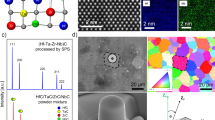Abstract
Knoop and Vickers hardness measurements have been made on tantalum carbide and hafnium carbide single crystals. The hardness varies with orientation of the indenter in the crystal, but indentations in the two carbides are of very different character, TaC behaves in a relatively ductile manner and deforms plastically before cracking, while HfC exhibits extremely limited plastic flow and cracks on indentation. Moreover, the preferred slip plane is {111} in TaC but is {110} in HfC. These results are related to the reported physical properties of these carbides. In particular, the observed mechanical behaviour of TaC appears to be consistent with the more metallic nature of this carbide.
Similar content being viewed by others

References
G. E. Hollox,Mater. Sci. Eng. 3 (1968/69) 121.
C. A. Brookes,Nature 228 (1970) 660.
D. J. Rowcliffe andW. J. Warren,J. Mater. Sci. 5 (1970) 345.
E. K. Storms, “The Refractory Carbides”, Academic Press, 1967.
F. W. Daniels andC. G. Dunn,Trans. ASM 41 (1949) 419.
C. A. Brookes, J. B. O'Neill, andB. A. W. Redfern,Proc. Roy. Soc. A 322 (1971) 73.
F. P. Bowden andD. Tabor, “The Friction and Lubrication of Solids”, Oxford University Press, 1964.
D. M. Marsh,Proc. Roy. Soc. A 279 (1964) 420.
W. S. Williams, International Conf. on Semi-Metallic Compounds, Orsay, 1965.
W. F. Brizes, University of Pittsburg, SRCC Report No.117 (1970).
R. Steinitz in “Nuclear Applications of Non-Fissionable Ceramics”, American Nuclear Society, Illinois (1966).
I. Cadoff, J. P. Nielsen, andE. Miller,Plansee Proceedings 2 (1955) 50.
L. Ramqvist,Jernkont. Ann. 153 (1969).
J. L. Martin andP. Costa, O.N.E.R.A., Paris, private communication.
H. Bibring, G. Seibel, andM. Rabinovitch, Transactions Second International Conference on The Strength of Metals and Alloys (1970), 1178.
J. J. Gilman,Acta Met. 7 (1959) 608.
H. R. Zeller, Brown Boveri Research Centre, private communication.
G. V. Samsonov, “High Temperature Materials”, Plenum Press, New York (1964).
C. M. Van DerWalt andM. J. Sole,Acta Met. 15 (1967) 459.
R. G. Lye in “Atomic and Electronic Structure of Metals”, ASM, Cleveland (1967).
D. J. Rowcliffe andO. E. Hollox,J. Mater. Sci., to be published.
Author information
Authors and Affiliations
Rights and permissions
About this article
Cite this article
Rowcliffe, D.J., Hollox, G.E. Plastic flow and fracture of tantalum carbide and hafnium carbide at low temperatures. J Mater Sci 6, 1261–1269 (1971). https://doi.org/10.1007/BF00552039
Received:
Accepted:
Issue Date:
DOI: https://doi.org/10.1007/BF00552039



